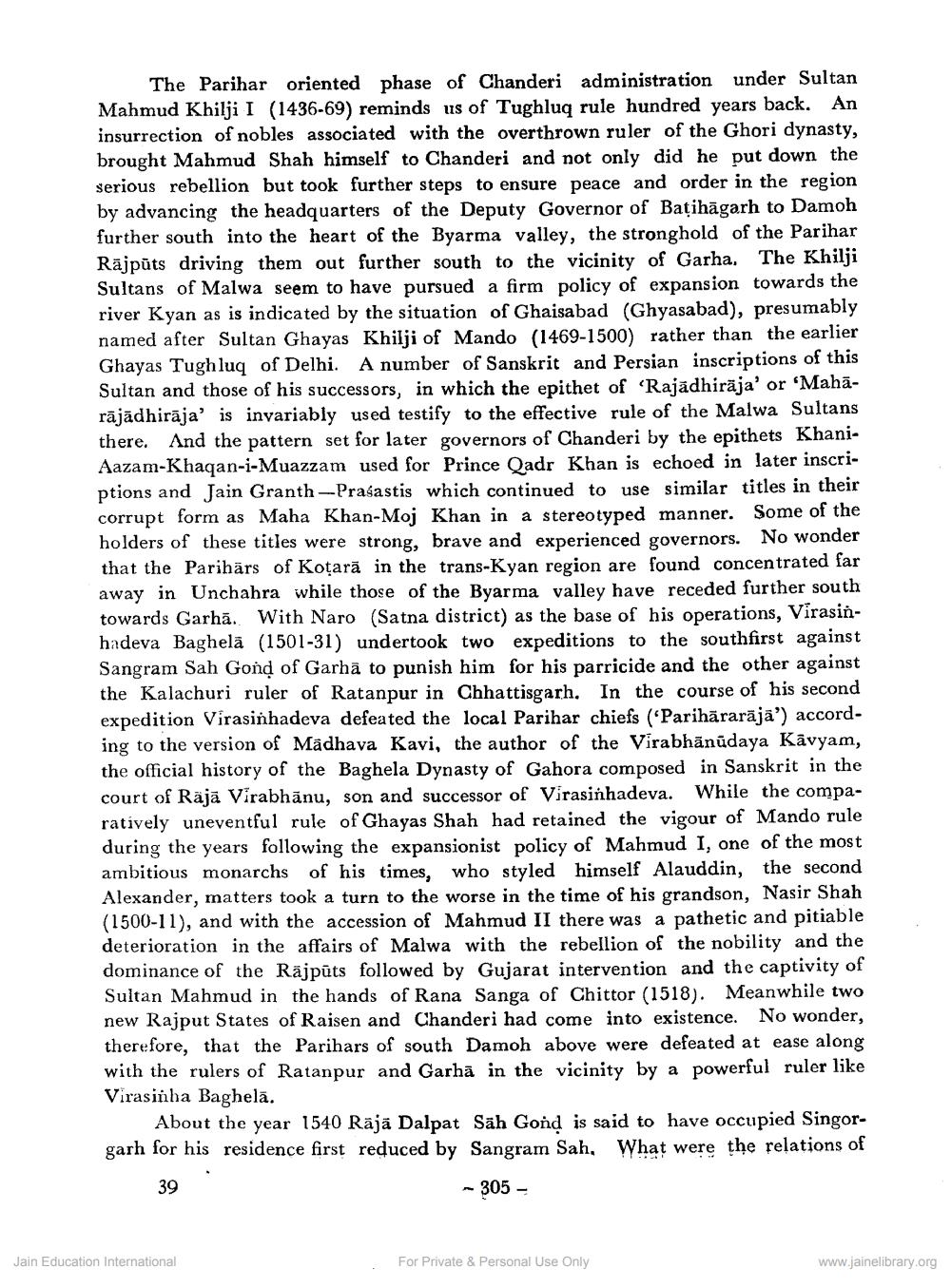Book Title: Chanderi Under Malva Sultansa Author(s): H A Nijamji Publisher: Z_Kailashchandra_Shastri_Abhinandan_Granth_012048.pdf View full book textPage 2
________________ The Parihar oriented phase of Chanderi administration under Sultan Mahmud Khilji I (1436-69) reminds us of Tughluq rule hundred years back. An insurrection of nobles associated with the overthrown ruler of the Ghori dynasty, brought Mahmud Shah himself to Chanderi and not only did he put down the serious rebellion but took further steps to ensure peace and order in the region by advancing the headquarters of the Deputy Governor of Batihāgarh to Damoh further south into the heart of the Byarma valley, the stronghold of the Parihar Rājpūts driving them out further south to the vicinity of Garha. The Khilji Sultans of Malwa seem to have pursued a firm policy of expansion towards the river Kyan as is indicated by the situation of Ghaisabad (Ghyasabad), presumably named after Sultan Ghayas Khilji of Mando (1469-1500) rather than the earlier Ghayas Tughluq of Delhi. A number of Sanskrit and Persian inscriptions of this Sultan and those of his successors, in which the epithet of 'Rajadhirāja' or 'Mahārājādhirāja' is invariably used testify to the effective rule of the Malwa Sultans there. And the pattern set for later governors of Chanderi by the epithets KhaniAazam-Khaqan-i-Muazzam used for Prince Qadr Khan is echoed in later inscriptions and Jain Granth --Prasastis which continued to use similar titles in their corrupt form as Maha Khan-Moj Khan in a stereotyped manner. Some of the holders of these titles were strong, brave and experienced governors. No wonder that the Parihärs of Kotarā in the trans-Kyan region are found concentrated far away in Unchahra while those of the Byarma valley have receded further south towards Garhā. With Naro (Satna district) as the base of his operations, Virasinhadeva Baghelā (1501-31) undertook two expeditions to the southfirst against Sangram Sah Gond of Garhā to punish him for his parricide and the other against the Kalachuri ruler of Ratanpur in Chhattisgarh. In the course of his second expedition Virasińhadeva defeated the local Parihar chiefs (“Parihārarājā') according to the version of Madhava Kavi, the author of the Virabhānūdaya Kävyam, the official history of the Baghela Dynasty of Gahora composed in Sanskrit in the court of Räjā Virabhānu, son and successor of Virasiñhadeva. While the comparatively uneventful rule of Ghayas Shah had retained the vigour of Mando rule during the years following the expansionist policy of Mahmud I, one of the most ambitious monarchs of his times, who styled himself Alauddin, the second Alexander, matters took a turn to the worse in the time of his grandson, Nasir Shah (1500-11), and with the accession of Mahmud II there was a pathetic and pitiable deterioration in the affairs of Malwa with the rebellion of the nobility and the dominance of the Räjpūts followed by Gujarat intervention and the captivity of Sultan Mahmud in the hands of Rana Sanga of Chittor (1518). Meanwhile two new Rajput States of Raisen and Chanderi had come into existence. No wonder, therefore, that the Parihars of south Damoh above were defeated at ease along with the rulers of Ratanpur and Garhā in the vicinity by a powerful ruler like Virasinha Baghela. About the year 1540 Räjä Dalpat Sāh Gond is said to have occupied Singorgarh for his residence first reduced by Sangram Sah. What were the relations of . 39 - 305 - Jain Education International For Private & Personal Use Only www.jainelibrary.orgPage Navigation
1 2 3 4 5 6 7 8
